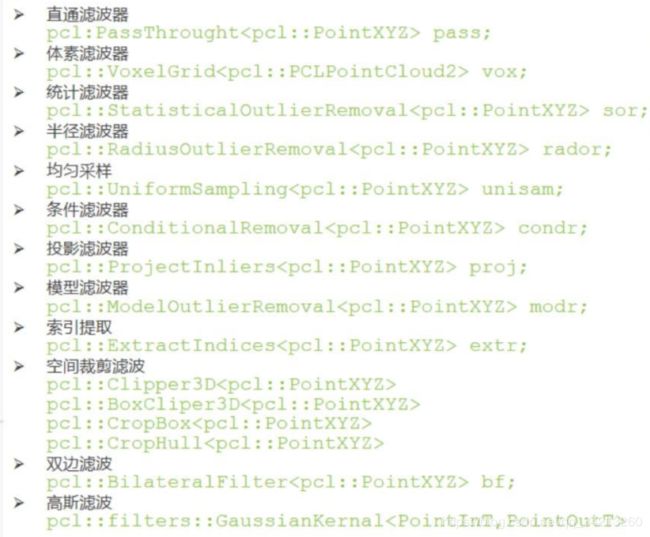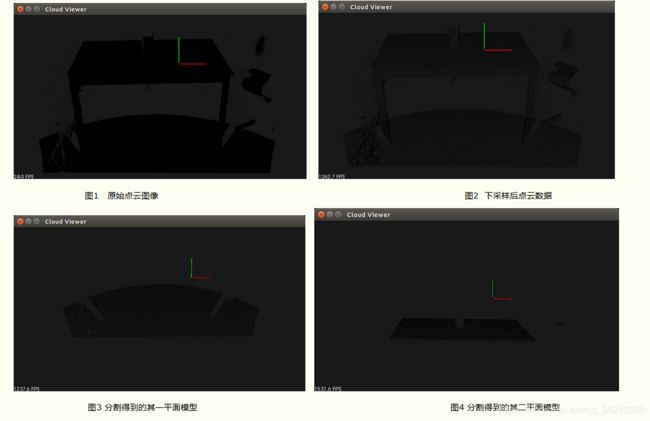PCL——(7)点云滤波
文章目录
- 一、简介
- 二、PCL中的滤波器
- 2.1 直通滤波器
- 2.2 使用VoxelGrid滤波器对点云进行下采样
- 2.3 statisticalOutlierRemoval滤波器移除离群点
- 2.4 使用参数化模型投影点云
- 2.5 从一个点云中提取索引(子集)
- 2.6 使用ConditionalRemoval 或RadiusOutlinerRemoval移除离群点
- 2.6.1 RadiusOutlierRemoval 原理
- 2.6.2 ConditionalRemoval 原理
- 2.7 双边滤波算法
- 2.8 CropHull任意多边形内部点云提取
- 2.9 均匀采样
- 打赏
- 支付宝
- 微信
一、简介

PCL中总结了几种需要进行点云滤波处理的情况,这几种情况如下:
- (1)点云数据密度不规则需要平滑。
- (2)因为遮挡等问题造成离群点需要去除。
- (3)大量数据需要进行下采样( Downsample)。
- (4)噪音数据需要去除。
对应的方法如下:
- (1)按具体给定的规则限制过滤去除点。
- (2)通过常用滤波算法修改点的部分属性。
- (3)对数据进行下采样,
二、PCL中的滤波器
2.1 直通滤波器
去除掉在用户指定某一维度上的指定范围内(或外)部的点。
#include 2.2 使用VoxelGrid滤波器对点云进行下采样
使用体素化网格方法实现下采样,即减少点的数量 减少点云数据,并同时保存点云的形状特征,在提高配准,曲面重建,形状识别等算法速度中非常实用,PCL是实现的VoxelGrid类通过输入的点云数据创建一个三维体素栅格,容纳后每个体素内用体素中所有点的重心来近似显示体素中其他点,这样该体素内所有点都用一个重心点最终表示,对于所有体素处理后得到的过滤后的点云,这种方法比用体素中心逼近的方法更慢,但是对于采样点对应曲面的表示更为准确。
#include 2.3 statisticalOutlierRemoval滤波器移除离群点
使用统计分析技术,从一个点云数据中集中移除测量噪声点(也就是离群点)比如:激光扫描通常会产生密度不均匀的点云数据集,另外测量中的误差也会产生稀疏的离群点,使效果不好,估计局部点云特征(例如采样点处法向量或曲率变化率)的运算复杂,这会导致错误的数值,反过来就会导致点云配准等后期的处理失败。
解决办法:每个点的邻域进行一个统计分析,并修剪掉一些不符合一定标准的点,稀疏离群点移除方法基于在输入数据中对点到临近点的距离分布的计算,对每一个点,计算它到它的所有临近点的平均距离,,假设得到的结果是一个高斯分布,其形状是由均值和标准差决定,平均距离在标准范围之外的点,可以被定义为离群点并可从数据中去除。

#include 2.4 使用参数化模型投影点云
将点投影到一个参数化模型上(平面或者球体等),参数化模型通过一组参数来设定,对于平面来说使用其等式形式: a x + b y + c z + d = 0 ax+by+cz+d=0 ax+by+cz+d=0.在PCL中有特意存储常见模型系数的数据结构.
#include 编译运行的结果如下

实验结果可以看出投影前的Z轴都不为0 ,都是随机产生的值,投影之后,打印的结果表明,xy的值都没有改变,z都变为0
所以该投影滤波类就是输入点云和投影模型,输出为投影到模型上之后的点云。
2.5 从一个点云中提取索引(子集)
基于某一分割算法提取点云中的一个子集。这里以平面分割算法为例:
#include 2.6 使用ConditionalRemoval 或RadiusOutlinerRemoval移除离群点
如何在滤波模块使用几种不同的方法移除离群点,对于ConditionalRemoval滤波器,可以一次删除满足对输入的点云设定的一个或多个条件指标的所有的数据点,RadiusOutlinerRemoval滤波器,它可以删除在输入点云一定范围内没有至少达到足够多近邻的所有数据点。
2.6.1 RadiusOutlierRemoval 原理
在点云数据中,用户指定每个点的一定范围内周围至少要有足够多的近邻。例如,如果指定至少要有1个邻居,只有黄色的点会被删除,如果指定至少要有2个邻居,黄色和绿色的点都将被删除。

关于RadiusOutlinerRemoval的理解,在点云数据中,设定每个点一定范围内周围至少有足够多的近邻,不满足就会被删除
2.6.2 ConditionalRemoval 原理
这个滤波器删除点云中不符合用户指定的一个或者多个条件的数据点
#include 2.7 双边滤波算法
双边滤波算法,是通过取邻近采样点的加权平均来修正当前采样点的位置,从而达到滤波效果。同时也会有选择地剔除部分与当前采样点“差异”太大的相邻采样点,从而达到保持原特征的目的。
2.8 CropHull任意多边形内部点云提取
2.9 均匀采样
pcl::UniformSampling<pcl::PointXYZ> unisam;
//设置滤波时创建的体素体积为1cm的立方体
//vox.setLeafSize (0.01f, 0.01f, 0.01f) ;
//设置滤波时创建的半径球体
unisam.setRadiusSearch(0.01f) ;
打赏
码字不易,如果对您有帮助,就打赏一下吧O(∩_∩)O
支付宝
![]()
微信
![]()

